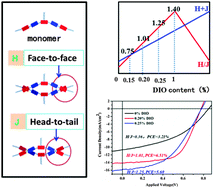Balancing the H- and J-aggregation in DTS(PTTh2)2/PC70BM to yield a high photovoltaic efficiency†
Abstract
The content and ratio of two stacking styles, namely H-aggregation and J-aggregation, of 5,5′-bis{(4-(7-hexylthiophen-2-yl)thiophen-2-yl)-[1,2,5]thiadiazolo[3,4-c]pyridine}-3,3′-di-2-ethylhexylsilylene-2,2′-bithiophene, DTS(PTTh2)2, had a profound influence on the performance of solar cells based on DTS(PTTh2)2/[6,6]-phenyl-C71-butyric acid methyl ester (PC70BM) (7/3, w/w) blend films. It was found that the H/J ratio could be tuned from 0.30 to 1.40 by controlling the boiling point of the main solvent, the content of additives and the selective dissolution by additives (such as 1,8-diiodooctane (DIO), 1,6-diiodohexane (DIH) and 1,4-diiodobutane (DIB)) of the DTS(PTTh2)2 side chains. The power conversion efficiency (PCE) of DTS(PTTh2)2/PC70BM was firstly improved, then decreased with increasing H/J ratio. The best PCE of 6.51% was achieved by adding 0.20 vol% 1,6-diiodohexane (DIO) into solutions in thiophene (Th), which improved it by 203% compared to the reference without additives, when the H/J ratio was 1.01. Balance between the two stacking styles is needed for the device to obtain best performance. On one hand, J-aggregation was favorable for forming more excitons because a lower energy was needed to excite the J-aggregation. On the other hand, the H-aggregation favored exciton dissociation for two reasons: providing excitons with a longer lifetime and stronger driving force for exciton dissociation. In addition, the complementary light absorption of the two stacking styles is advantageous for maximal light absorption.


 Please wait while we load your content...
Please wait while we load your content...